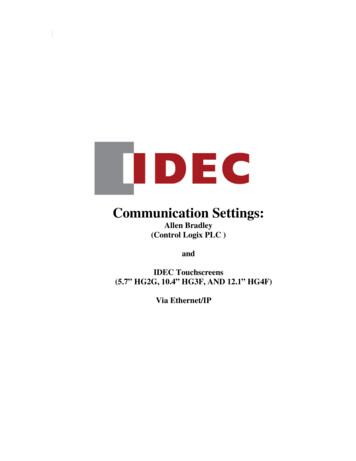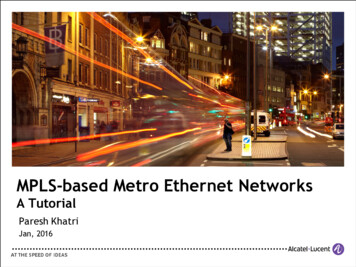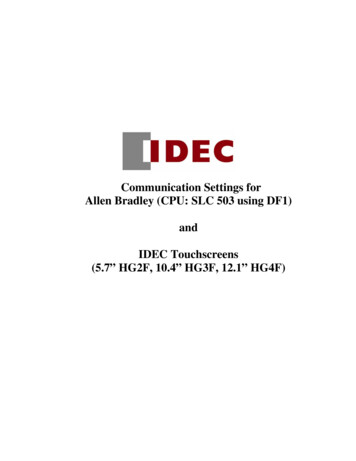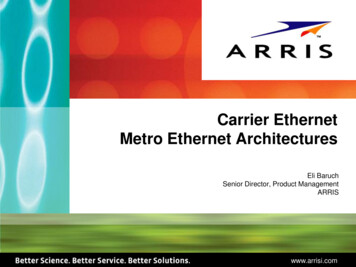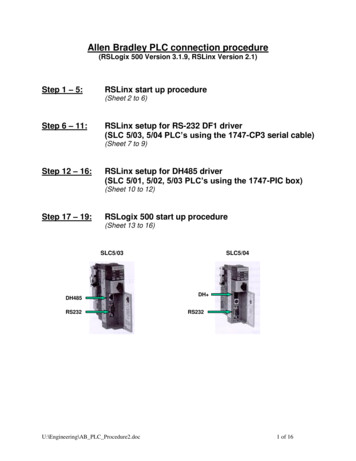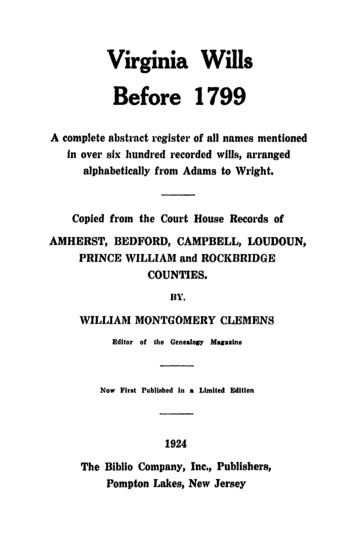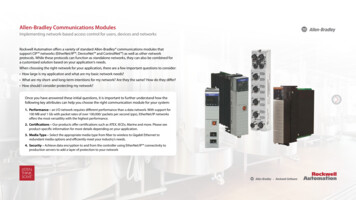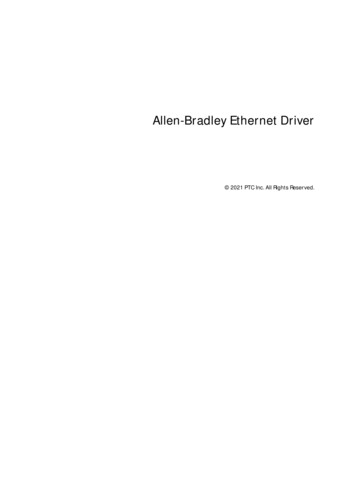
Transcription
Allen-Bradley Ethernet Driver 2021 PTC Inc. All Rights Reserved.
Allen-Bradley Ethernet Driver2Table of ContentsAllen-Bradley Ethernet Driver1Table of Contents2Allen-Bradley Ethernet Driver4Overview5Setup6Channel Properties — General7Channel Properties — Ethernet Communications8Channel Properties — Write Optimizations8Channel Properties — Advanced9Channel Properties — Communication Serialization10Device Properties — General — Identification11Operating Mode11Device Properties — Scan Mode12Device Properties — Timing13Device Properties — Auto-Demotion14Device Properties — Communications Parameters14Device Properties — Protocol Parameters15Device Properties — Slot Configuration15Device Properties — Redundancy16Modular I/O Selection Guide17Optimizing Communications20Data Types Description21Address Descriptions22General Addressing22Output Files22Input Files24Status Files26Binary Files27Timer Files28Counter Files29Control Files29Integer Files30Float Files31ASCII Files32String Files33String Length33www. ptc.com
Allen -Brad ley Eth ern et Driver3SLC 5/05 Open Addressing34PLC-5 Family and SoftPLC Addressing34BCD Files34PID Files35Message Files37Block Transfer Files38Event Log M essages39Unable to read data block from device. Frame received contains errors. Block start address ' address '.39Unable to read data block from the device. Tag deactivated. Block start address ' address ',Status code code , Extended status code code .39Unable to write to address on device. Frame received contains errors. Address ' address '.40Unable to read data block from device. Block start address ' address ', Status code code ,Extended status code code .40Unable to read data block from device. Tag deactivated. Block start address ' address ',Status code code .41Unable to write to address on device. Address ' address ', Status code code , Extendedstatus code code .42Unable to read data block from device. Block start address ' address ', Status code code . 42Unable to write to address on device. Address ' address ', Status code code .43Unable to write to address on device. Packet length is out of range. Address ' address ',Expected packet length low to high (bytes).44Unable to write to address on device. TNS is out of range. Address ' address ', Expected TNSrange low to high .44Index45www. ptc.com
Allen -Brad ley Eth ern et Driver4Allen-Bradley Et hernet DriverHelp version 1.057CONTENTSOverviewWhat is the Allen-Bradley Ethernet Driver?Device Set upHow do I configure a device for use with this driver?Opt imizing Communicat ionsHow do I get the best performance from the Allen-Bradley Ethernet Driver?Dat a Types Descript ionWhat data types are supported by this driver?Address Descript ionsHow do I address a data location on an Allen-Bradley Ethernet device?Event Log M essagesWhat messages are produced by the driver?www. ptc.com
Allen-Bradley Ethernet Driver5OverviewThe Allen-Bradley Ethernet Driver provides a reliable way to connect Allen-Bradley Ethernet devices to clientapplications; including HMI, SCADA, Historian, MES, ERP, and countless custom applications. This driver supports the Allen Bradley SLC 5/05 series, PLC-5 series, and SoftPLC PLCs. Address ranges are open to supportfuture models for this series of PLCs.www. ptc.com
Allen -Brad ley Eth ern et Driver6Set upCommunication ProtocolAllen-Bradley EthernetSupported DevicesSLC 5/05 processor*PLC-5 series (excluding the PLC-5/250 series)SoftPLC* Address ranges are open in the driver to allow for new devices. The driver may support a device even if it isnot listed above.Channel and Device LimitsThe maximum number of channels supported by this driver is 256. The maximum number of devices supported by this driver is 1024 per channel.www. ptc.com
Allen-Bradley Ethernet Driver7Channel Propert ies — GeneralThis server supports the use of multiple simultaneous communications drivers. Each protocol or driver usedin a server project is called a channel. A server project may consist of many channels with the same communications driver or with unique communications drivers. A channel acts as the basic building block of anOPC link. This group is used to specify general channel properties, such as the identification attributes andoperating mode.IdentificationN am e: Specify the user-defined identity of this channel. In each server project, each channel name must beunique. Although names can be up to 256 characters, some client applications have a limited display windowwhen browsing the OPC server's tag space. The channel name is part of the OPC browser information. Theproperty is required for creating a channel.For information on reserved characters, refer to "How To. Properly Name a Channel, Device, Tag, and TagGroup" in the server help.Description: Specify user-defined information about this channel.Many of these properties, including Description, have an associated system tag.Driver: Specify the protocol / driver for this channel. This property specifies the device driver that was selected during channel creation. It is a disabled setting in the channel properties. The property is required for creating a channel.N ote: With the server's online full-time operation, these properties can be changed at any time. Thisincludes changing the channel name to prevent clients from registering data with the server. If a client hasalready acquired an item from the server before the channel name is changed, the items are unaffected. If,after the channel name has been changed, the client application releases the item and attempts to reacquire using the old channel name, the item is not accepted. Changes to the properties should not be madeonce a large client application has been developed. Utilize proper user role and privilege management toprevent operators from changing properties or accessing server features.DiagnosticsDiagnostics Capture: When enabled, this option makes the channel's diagnostic information available toOPC applications. Because the server's diagnostic features require a minimal amount of overhead processing, it is recommended that they be utilized when needed and disabled when not. The default is disabled.N ote: This property is not available if the driver does not support diagnostics.For more information, refer to "Communication Diagnostics" and "Statistics Tags" in the server help.www. ptc.com
Allen -Brad ley Eth ern et Driver8Channel Propert ies — Et hernet Com m unicat ionsEthernet Communication can be used to communicate with devices.Ethernet SettingsN etwork Adapter: Specify the network adapter to bind. When left blank or Default is selected, the operating system selects the default adapter.Channel Propert ies — Writ e Opt im izat ionsThe server must ensure that the data written from the client application gets to the device on time. Giventhis goal, the server provides optimization properties to meet specific needs or improve application responsiveness.Write OptimizationsOptim ization Method: Controls how write data is passed to the underlying communications driver. Theoptions are:llWrite All Values for All Tags: This option forces the server to attempt to write every value to thecontroller. In this mode, the server continues to gather write requests and add them to the server'sinternal write queue. The server processes the write queue and attempts to empty it by writing datato the device as quickly as possible. This mode ensures that everything written from the client applications is sent to the target device. This mode should be selected if the write operation order or thewrite item's content must uniquely be seen at the target device.Write Only Latest Value for N on-Boolean Tags: Many consecutive writes to the same value canaccumulate in the write queue due to the time required to actually send the data to the device. If theserver updates a write value that has already been placed in the write queue, far fewer writes areneeded to reach the same final output value. In this way, no extra writes accumulate in the server'squeue. When the user stops moving the slide switch, the value in the device is at the correct value atvirtually the same time. As the mode states, any value that is not a Boolean value is updated in theserver's internal write queue and sent to the device at the next possible opportunity. This can greatlyimprove the application performance.N ote: This option does not attempt to optimize writes to Boolean values. It allows users to optimizethe operation of HMI data without causing problems with Boolean operations, such as a momentarypush button.lWrite Only Latest Value for All Tags: This option takes the theory behind the second optimizationmode and applies it to all tags. It is especially useful if the application only needs to send the latestwww. ptc.com
Allen-Bradley Ethernet Driver9value to the device. This mode optimizes all writes by updating the tags currently in the write queuebefore they are sent. This is the default mode.Duty Cycle: is used to control the ratio of write to read operations. The ratio is always based on one read forevery one to ten writes. The duty cycle is set to ten by default, meaning that ten writes occur for each readoperation. Although the application is performing a large number of continuous writes, it must be ensuredthat read data is still given time to process. A setting of one results in one read operation for every writeoperation. If there are no write operations to perform, reads are processed continuously. This allows optimization for applications with continuous writes versus a more balanced back and forth data flow.N ote: It is recommended that the application be characterized for compatibility with the write optimizationenhancements before being used in a production environment.Channel Propert ies — AdvancedThis group is used to specify advanced channel properties. Not all drivers support all properties; so theAdvanced group does not appear for those devices.N on-N orm alized Float Handling: A non-normalized value is defined as Infinity, Not-a-Number (NaN), or asa Denormalized Number. The default is Replace with Zero. Drivers that have native float handling maydefault to Unmodified. Non-normalized float handling allows users to specify how a driver handles non-normalized IEEE-754 floating point data. Descriptions of the options are as follows:llReplace with Zero: This option allows a driver to replace non-normalized IEEE-754 floating point values with zero before being transferred to clients.Unm odified: This option allows a driver to transfer IEEE-754 denormalized, normalized, non-number, and infinity values to clients without any conversion or changes.N ote: This property is not available if the driver does not support floating-point values or if it only supportsthe option that is displayed. According to the channel's float normalization setting, only real-time driver tags(such as values and arrays) are subject to float normalization. For example, EFM data is not affected by thissetting.For more information on the floating-point values, refer to "How To . Work with Non-Normalized FloatingPoint Values" in the server help.Inter-Device Delay: Specify the amount of time the communications channel waits to send new requests tothe next device after data is received from the current device on the same channel. Zero (0) disables thedelay.N ote: This property is not available for all drivers, models, and dependent settings.www. ptc.com
Allen -Brad ley Eth ern et Driver10Channel Propert ies — Com m unicat ion Serializat ionThe server's multi-threading architecture allows channels to communicate with devices in parallel. Althoughthis is efficient, communication can be serialized in cases with physical network restrictions (such as Ethernet radios). Communication serialization limits communication to one channel at a time within a virtual network.The term "virtual network" describes a collection of channels and associated devices that use the samepipeline for communications. For example, the pipeline of an Ethernet radio is the client radio. All channelsusing the same client radio associate with the same virtual network. Channels are allowed to communicateeach in turn, in a "round-robin" manner. By default, a channel can process one transaction before handingcommunications off to another channel. A transaction can include one or more tags. If the controlling channel contains a device that is not responding to a request, the channel cannot release control until the transaction times out. This results in data update delays for the other channels in the virtual network.Channel-Level SettingsVirtual N etwork: Specify the channel's mode of communication serialization. Options include None and Network 1 - Network 500. The default is None. Descriptions of the options are as follows:llN one: This option disables communication serialization for the channel.N etwork 1 - N etwork 500: This option specifies the virtual network to which the channel isassigned.Transactions per Cycle: Specify the number of single blocked/non-blocked read/write transactions that canoccur on the channel. When a channel is given the opportunity to communicate, this is the number of transactions attempted. The valid range is 1 to 99. The default is 1.Global SettingsN etwork Mode: This property is used to control how channel communication is delegated. In Load Balanced mode, each channel is given the opportunity to communicate in turn, one at a time. In Priority mode,channels are given the opportunity to communicate according to the following rules (highest to lowest priority):1. Channels with pending writes have the highest priority.2. Channels with pending explicit reads (through internal plug-ins or external client interfaces) are prioritized based on the read's priority.3. Scanned reads and other periodic events (driver specific).The default is Load Balanced and affects all virtual networks and channels.Devices that rely on unsolicited responses should not be placed in a virtual network. In situations wherecommunications must be serialized, it is recommended that Auto-Demotion be enabled.www. ptc.com
Allen-Bradley Ethernet Driver11Due to differences in the way that drivers read and write data (such as in single, blocked, or non-blockedtransactions); the application's Transactions per cycle property may need to be adjusted. When doing so,consider the following factors:lHow many tags must be read from each channel?lHow often is data written to each channel?lIs the channel using a serial or Ethernet driver?lDoes the driver read tags in separate requests, or are multiple tags read in a block?lHave the device's Timing properties (such as Request timeout and Fail after x successive timeouts)been optimized for the virtual network's communication medium?Device Propert ies — General — Ident ificat ionN am e: User-defined identity of this device.Description: User-defined information about this device.Channel Assignm ent: User-defined name of the channel to which this device currently belongs.Driver: Selected protocol driver for this device.Model: The specific version of the device.ID: The device ID is the network address of the PLC.See Also: Operating ModeOperating M odeData Collection: This property controls the device's active state. Although device communications areenabled by default, this property can be used to disable a physical device. Communications are not attempted when a device is disabled. From a client standpoint, the data is marked as invalid and write operationsare not accepted. This property can be changed at any time through this property or the device system tags.www. ptc.com
Allen -Brad ley Eth ern et Driver12Sim ulated: Place the device into or out of Simulation Mode. In this mode, the driver does not attempt tocommunicate with the physical device, but the server continues to return valid OPC data. Simulated stopsphysical communications with the device, but allows OPC data to be returned to the OPC client as valid data.While in Simulation Mode, the server treats all device data as reflective: whatever is written to the simulateddevice is read back and each OPC item is treated individually. The item's memory map is based on the groupUpdate Rate. The data is not saved if the server removes the item (such as when the server is reinitialized).The default is No.N otes:1. This System tag ( Simulated) is read only and cannot be written to for runtime protection. The Systemtag allows this property to be monitored from the client.2. In Simulation mode, the item's memory map is based on client update rate(s) (Group Update Rate forOPC clients or Scan Rate for native and DDE interfaces). This means that two clients that referencethe same item with different update rates return different data.Simulation Mode is for test and simulation purposes only. It should never be used in a production environment.Device Propert ies — Scan M odeThe Scan Mode specifies the subscribed-client requested scan rate for tags that require device communications. Synchronous and asynchronous device reads and writes are processed as soon as possible;unaffected by the Scan Mode properties.Scan Mode: Specify how tags in the device are scanned for updates sent to subscribing clients. Descriptionsof the options are:lllllRespect Client-Specified Scan Rate: This mode uses the scan rate requested by the client.Request Data N o Faster than Scan Rate: This mode specifies the value set as the maximum scanrate. The valid range is 10 to 99999990 milliseconds. The default is 1000 milliseconds.N ote: When the server has an active client and items for the device and the scan rate value isincreased, the changes take effect immediately. When the scan rate value is decreased, the changesdo not take effect until all client applications have been disconnected.Request All Data at Scan Rate: This mode forces tags to be scanned at the specified rate for subscribed clients. The valid range is 10 to 99999990 milliseconds. The default is 1000 milliseconds.Do N ot Scan, Dem and Poll Only: This mode does not periodically poll tags that belong to thedevice nor perform a read to get an item's initial value once it becomes active. It is the OPC client'sresponsibility to poll for updates, either by writing to the DemandPoll tag or by issuing explicit devicereads for individual items. For more information, refer to "Device Demand Poll" in server help.Respect Tag-Specified Scan Rate: This mode forces static tags to be scanned at the rate specifiedin their static configuration tag properties. Dynamic tags are scanned at the client-specified scanrate.Initial Updates from Cache: When enabled, this option allows the server to provide the first updates fornewly activated tag references from stored (cached) data. Cache updates can only be provided when thenew item reference shares the same address, scan rate, data type, client access, and scaling properties. Awww. ptc.com
Allen-Bradley Ethernet Driver13device read is used for the initial update for the first client reference only. The default is disabled; any time aclient activates a tag reference the server attempts to read the initial value from the device.Device Propert ies — Tim ingThe device Timing properties allow the driver's response to error conditions to be tailored to fit the application's needs. In many cases, the environment requires changes to these properties for optimum performance. Factors such as electrically generated noise, modem delays, and poor physical connections caninfluence how many errors or timeouts a communications driver encounters. Timing properties are specificto each configured device.Communications TimeoutsConnect Tim eout: This property (which is used primarily by Ethernet based drivers) controls the amount oftime required to establish a socket connection to a remote device. The device's connection time often takeslonger than normal communications requests to that same device. The valid range is 1 to 30 seconds. Thedefault is typically 3 seconds, but can vary depending on the driver's specific nature. If this setting is not supported by the driver, it is disabled.N ote: Due to the nature of UDP connections, the connection timeout setting is not applicable when communicating via UDP.Request Tim eout: Specify an interval used by all drivers to determine how long the driver waits for aresponse from the target device to complete. The valid range is 50 to 9,999,999 milliseconds (167.6667minutes). The default is usually 1000 milliseconds, but can vary depending on the driver. The default timeoutfor most serial drivers is based on a baud rate of 9600 baud or better. When using a driver at lower baudrates, increase the timeout to compensate for the increased time required to acquire data.Attem pts Before Tim eout: Specify how many times the driver issues a communications request before considering the request to have failed and the device to be in error. The valid range is 1 to 10. The default is typically 3, but can vary depending on the driver's specific nature. The number of attempts configured for anapplication depends largely on the communications environment. This property applies to both connectionattempts and request attempts.TimingInter-Request Delay: Specify how long the driver waits before sending the next request to the targetdevice. It overrides the normal polling frequency of tags associated with the device, as well as one-timereads and writes. This delay can be useful when dealing with devices with slow turnaround times and incases where network load is a concern. Configuring a delay for a device affects communications with allother devices on the channel. It is recommended that users separate any device that requires an interrequest delay to a separate channel if possible. Other communications properties (such as communicationserialization) can extend this delay. The valid range is 0 to 300,000 milliseconds; however, some drivers maylimit the maximum value due to a function of their particular design. The default is 0, which indicates nodelay between requests with the target device.N ote: Not all drivers support Inter-Request Delay. This setting does not appear if it is not available.www. ptc.com
Allen -Brad ley Eth ern et Driver14Device Propert ies — Aut o-Dem ot ionThe Auto-Demotion properties can temporarily place a device off-scan in the event that a device is notresponding. By placing a non-responsive device offline for a specific time period, the driver can continue tooptimize its communications with other devices on the same channel. After the time period has beenreached, the driver re-attempts to communicate with the non-responsive device. If the device is responsive,the device is placed on-scan; otherwise, it restarts its off-scan time period.Dem ote on Failure: When enabled, the device is automatically taken off-scan until it is responding again.Tip: Determine when a device is off-scan by monitoring its demoted state using the AutoDemoted system tag.Tim eouts to Dem ote: Specify how many successive cycles of request timeouts and retries occur before thedevice is placed off-scan. The valid range is 1 to 30 successive failures. The default is 3.Dem otion Period: Indicate how long the device should be placed off-scan when the timeouts value isreached. During this period, no read requests are sent to the device and all data associated with the readrequests are set to bad quality. When this period expires, the driver places the device on-scan and allows foranother attempt at communications. The valid range is 100 to 3600000 milliseconds. The default is 10000milliseconds.Discard Requests when Dem oted: Select whether or not write requests should be attempted during theoff-scan period. Disable to always send write requests regardless of the demotion period. Enable to discardwrites; the server automatically fails any write request received from a client and does not post a messageto the Event Log.Device Propert ies — Com m unicat ions Param et ersPort: Specify the port number that the remote device is configured to use. The default setting is 2222.Request Size: Specify the maximum number of bytes that may be requested from a device at one time. Torefine the driver's performance, configure the request size to one of the following settings: 32, 64, 128, 256,512, 1024, or 2000 bytes. The default is 512 bytes.www. ptc.com
Allen-Bradley Ethernet Driver15Tip: For Boolean arrays, the block size is the bit equivalent (or, block size multiplied by 8). For example, ablock size of 512 bytes is equal to 512 * 8 4096 bits.Device Propert ies — Prot ocol Param et ersDestination N ode Address (DST): Specify the destination node address. For DF1 gateway applications,select the node address of the destination device. For non-DF1 gateway applications, leave the node addressat the default setting of 0.N ote: The destination device is the DH or DH-485 device.Device Propert ies — Slot Configurat ionSLC500 models (with modular I/O racks) must be configured for use with this driver if the I/O is to beaccessed by the driver. Up to 30 slots can be configured per device.To use the slot configuration:www. ptc.com
Allen -Brad ley Eth ern et Driver161. Select the slot to be configured by clicking on the row in the module list box.2. To select a module, click on it from the available modules drop-down list.3. Configure the Input Words and Output Words if necessary.4. To remove a slot / module, select N o Module from the available modules drop-down list.5. When complete, click OK.Tip: Use the 0000-Generic Module to configure I/O that is not contained in the list of Available Modules.N ote: It is common to have open slots in the rack that do not contain a physical module. To correctlyaccess data for the various slots that do contain a module, the preceding module(s) must have the correctnumber of words mapped. For example, if only interested in the I/O in slot 3, but slots 1 and 2 contain I/Omodules, the correct modules must be selected for slots 1, 2, and 3 from this slot configuration group.0000-Generic ModuleUse the Generic Module to map Input and Output words for modules that are not represented in the list ofavailable modules. To correctly use the Generic Module, users must know the number of Input and Outputwords required for each module.Consult Allen-Bradley I/O user manual documentation to confirm Input and Output requirements and beaware that requirements may be different based on Class 1 or Class 3 operation.For information on the number of input and output words available for each I/O module, refer to ModularI/ O Selection Guide.Device Propert ies — RedundancyRedundancy is available with the Media-Level Redundancy Plug-In.Consult the website, a sales representative, or the user manual for more information.www. ptc.com
Allen-Bradley Ethernet Driver17M odular I/ O Select ion GuideThe following table lists the number of input and output words available for each I/O module in the Slot Configuration list.Tip: Use the Generic Module to map input and output words for modules that are not represented in thelist of available modules. The range of accepted values is shown in the table below.Consult the Allen-Bradley user manual for the specific I/O module to configure to confirm input and outputrequirements. Requirements may be different based on Class 1 or Class 3 operation.M odule TypeInput WordsOut put Words0-2550-2551203-SM1 SCANport Comm Module - Basic881203-SM1 SCANport Comm Module - Enhanced32321394-SJT GMC Turbo System32321746-BAS Basic Module 500 5/01 Configuration881746-BAS Basic Module 5/02 Configuration881746-HS Single Axis Motion Controller441746-HSCE High-Speed Counter/Encoder811746-HSRV Motion Control Module1281746-HSTP1 Stepper Controller Module881746-I* 16 Any 16 pt Discrete Input Module101746-I* 32 Any 32 pt Discrete Input Module201746-I* 8 Any 8 pt Discrete Input Module101746-IA16 16 Input 100/120 VAC101746-IA4 4 Input 100/120 VAC101746-IA8 8 Input 100/120 VAC101746-IB16 16 Input (Sink) 24 VDC101746-IB32 32 Input (Sink) 24 VDC201746-IB8 8 Input (Sink) 24 VDC101746-IC16 16 Input (Sink) 48 VDC101746-IG16 16 Input [TTL] (Source) 5 VDC101746-IH16 16 Input [Trans] (Sink) 125 VDC101746-IM16 16 Input 200/240 VAC101746-IM4 4 Input 200/240 VAC101746-IM8 8 Input 200/240 VAC101746-IN16 16 Input 24 VAC/VDC101746-INI4I Analog 4 Ch. Isol. Current Input881746-INI4VI Analog 4 Ch. Isol. Volt./Current Input881746-INO4I Analog 4 Ch. Isol. Current Input881746-INO4VI Analog 4 Ch. Isol. Volt./Current Input881746-INT4 4 Ch. Isolated Thermocouple Input880000-Generic Modulewww. ptc.com
Allen -Brad ley Eth ern et Driver18M odule TypeInput WordsOut put Words1746-IO12 6 In 100/120 VAC 6 Out [Rly] VAC/VDC111746-IO12DC 6 Input 12 VDC, 6 Output [Rly111746-IO4 2 In 100/120 VAC 2 Out [Rly] VAC/VDC3111746-IO8 4 In 100/120 VAC 4 Out [Rly] VAC/VDC4111746-ITB16 16 Input [Fast] (Sink) 24 VDC101746-ITV16 16 Input [Fast] (Source) 24 VDC101746-IV16 16 Input (Source) 24 VDC101746-IV32 32 Input (Source) 24 VDC201746-IV8 8 Input (Source) 24 VDC101746-NI4 4 Ch Analog Input401746-NI8 8 Ch Analog Input, Class 1881746-NI8 8 Ch Analog Input, Class 316121746-NIO4I Analog Comb 2 in & 2 Current Out221746-NIO4V Analog Comb 2 in & 2 Voltage Out221746-NO4I 4 Ch Analog Current Output041746-NO4V 4 Ch Analog Voltage Output041746-NR4 4 Ch Rtd/Resistance Input Module881746-NT4 4 Ch Thermocouple Input Module881746-NT8 Analog 8 Ch Thermocouple Input881746-O* 16 Any 16 pt Discrete Output Module011746-O* 32 Any 32 pt Discrete Output Module021746-O* 8 Any 8 pt Discrete Output Module011746-OA16 16 Output (Triac) 100/240 VAC011746-OA8 8 Output (Triac) 100/240 VAC011746-OAP12 12 Output [Triac] 120/240 VDC011746-OB16 16 Output [Trans] (Source) 10/50 VDC011746-OB16E 16 Output [Trans] (Source) Protected011746-OB32 32 Output [Trans] (Source) 10/50 VDC021746-OB32E 32 O
Allen-BradleyEthernetDriver TableofContents Allen-BradleyEthernetDriver 1 TableofContents 2 Allen-BradleyEthernetDriver 4 Overview 5 Setup 6 ChannelProperties— General 7 ChannelProperties— EthernetCommunications 8 ChannelProperties— WriteOptimizations 8 ChannelProperties— Advanced 9 ChannelProperties— CommunicationSerialization 10
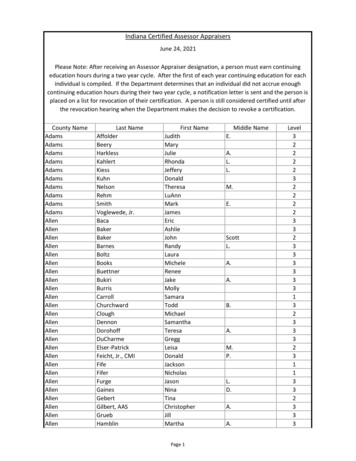
![INDEX [gfgenealogy ]](/img/44/index-to-wills-cascade-county.jpg)
